Raiders of the Lost Ark (c’mon, man, it’s not Indiana Jones and the Raiders of the Lost Ark)
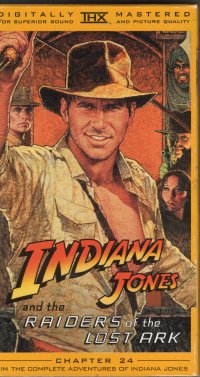 Well, since I just read the novelization of this film, of course I was going to rewatch the series. Well, the real Indiana Jones movies. I picked up a VHS box set from the turn of the century (it looks like the commentary is copyright 1999). Which is why the videocassettes call these Chapter 24, Chapter 23, and Chapter 25 respectively; the Young Indiana Jones Chronicles, a two season series plus four television movies, comprise the first 22 chapters of the story. And as far as the 21st century entries into the film canon go, well, we will not speak of them again.
Well, since I just read the novelization of this film, of course I was going to rewatch the series. Well, the real Indiana Jones movies. I picked up a VHS box set from the turn of the century (it looks like the commentary is copyright 1999). Which is why the videocassettes call these Chapter 24, Chapter 23, and Chapter 25 respectively; the Young Indiana Jones Chronicles, a two season series plus four television movies, comprise the first 22 chapters of the story. And as far as the 21st century entries into the film canon go, well, we will not speak of them again.
So, Raiders of the Lost Ark: In the cold open, Indiana Jones is in a South American jungle, looking for an idol in a lost temple. When he reveals a map, one of his partners draws a weapon, only to have Jones whip it out of his hand. Native bearers flee when they reach the temple, and Jones and his remaining partner, Doctor Octopus, enter. Jones seemingly discovers the booby traps and swaps the idol for a bag of sand, and he must flee a final trap–the rolling boulder–and a betrayal from Doctor Octopus, and….
Well, never mind, gentle reader. You already know the story, and if you do not, you should definitely watch the movie and not read a recap. So I will just jump into my normal commentary on the film(s).
I did not see Raiders of the Lost Ark in the theaters, and it was some years after it came out on home video and cable that I saw it. I was familiar with the story, though, as I had one or more comic books telling at least part of the story. For some reason, I think I saw this in school, maybe in high school, eventually, and I’ve only seen it a couple of times since then. However, Indiana Jones was part of the zeitgeist in the 1980s, and it probably more than anything else popularized the archeologist/treasure hunter archetype that had a healthy go of it in the era–see also Firewalker, the Allan Quatermain movies King Solomon’s Mines and Allan Quatermain and the Lost City of Gold, and the Romancing the Stone/Jewel of the Nile movies and so on.
Sometime around the turn of the century, about the time I decided to ditch the gas permeable contact lenses and wear glasses instead, my beautiful wife decided that I looked like Toht, one of the bad guys in the film. So I asked her to write a JavaScript clickable image carousel for me, and Toht Or Not was born (and originally hosted on Geocities).
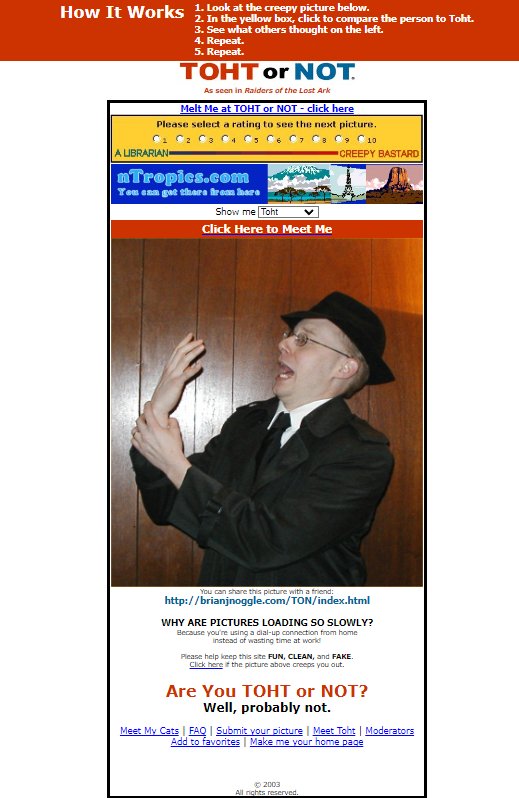
I posted that on Slack where I work (for the nonce), and those kids were not familiar with a lot of the concepts therein, such as dial up connection and certainly Hot or Not, which was a thing in 2003.
At any rate, Lucas and Spielberg put together a rollicking adventure that moved very well.
Oft quoted lines:
- “Top. Men.”
- “Snakes. Why did it have to be snakes?”
As I suspected, the book is paced a little differently than the book and includes several scenes which were not in the movie, particularly in the beginning of the film when the Nazis decide to go for the ark. It differentiates and elaborates on the German chain of command in a way that is lost in the film. And although Marion in the movie says that she was a child during her earlier affair with Jones, we’re left to imagine what that is. 18? 19? In the book, she goes on and mentions she was fifteen. No telling on whether that was in the script, filmed, and/or cut or if the novelizationer added that in.
Indiana Jones and the Temple of Doom
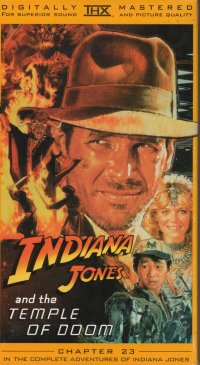 This film, the events of which take place before Raiders of the Lost Ark, has a cold open where Jones has recovered the remains of a Chinese emperor for a gangster who does not want to pay and double-crosses Jones. Jones escapes with his life and the singer at the gangster’s nightclub, and although they (and Short Round, the annoying young sidekick) think they’ve gotten away, they’re passengers on a plane owned by the gangster–and the pilots bail out while Jones and crew are sleeping. Their narrow escape as the plane crashes in the Himalayas brings them to a village in India where the home stone has been stolen, and Jones decides to help return it. Which leads them to a fortress and a renegade rajah and a cult, including the cult leader who rips out still-beating hearts during rituals. Which is the gross-out moment in this film (akin to the face-melting in Raiders of the Lost Ark).
This film, the events of which take place before Raiders of the Lost Ark, has a cold open where Jones has recovered the remains of a Chinese emperor for a gangster who does not want to pay and double-crosses Jones. Jones escapes with his life and the singer at the gangster’s nightclub, and although they (and Short Round, the annoying young sidekick) think they’ve gotten away, they’re passengers on a plane owned by the gangster–and the pilots bail out while Jones and crew are sleeping. Their narrow escape as the plane crashes in the Himalayas brings them to a village in India where the home stone has been stolen, and Jones decides to help return it. Which leads them to a fortress and a renegade rajah and a cult, including the cult leader who rips out still-beating hearts during rituals. Which is the gross-out moment in this film (akin to the face-melting in Raiders of the Lost Ark).
The film features some callbacks and in-jokes–the gangster’s club is Club Obi Wan, and at one point Indiana Jones faces not one, but two swordsmen who twirl their swords before attacking, and he reaches for his holster–but unlike in Raiders, he finds it empty and says, “Heh.” So already there’s a touch of fan service.
But the mine cart chase scene. Boy, howdy, did that go on for too long. Indiana, the nightclub singer, and Short Round hop into a mine cart to escape the bad guys from a–well, it’s not a mine, it’s a dig for the remaining Macguffins–and bad guys pursue them in other carts. Man, I don’t know if they were grabbing onto a height of roller coaster fame or if they had visions of future theme park attractions dancing in their heads, but the sequence is a bit over-the-top ridiculous.
It has gotten a bit of a bad reputation as the red-haired step-child of the Indiana Jones movies (before the delinquent foster children came along), but it’s not a bad sample of the genre. According to the Wikipedia entry, they set the film before Raiders so they wouldn’t have to make Nazis the bad guys again. If only they’d stuck with that. But in the 21st century, that’s the only real evil the world has seen, so it (and, perhaps, Republicans) are the only allowed villains in these simpler times.
Oft quoted lines:
Well, none, really, although maybe I will start saying, “Fortune and glory, kid. Fortune and glory,” to change that. Although my kids are not really kids any more.
Indiana Jones and the Last Crusade
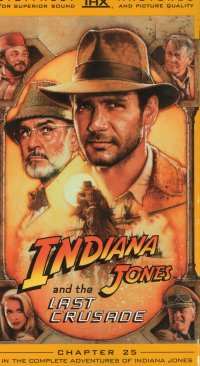 I saw this film in the theater, gentle reader, I think. It seems to me that my brother and I came into a windfall that summer when the owner of my father’s favorite tavern at the time hired us to load a roll-on dumpster with junk stored in the three- or four-bay garage attached to the saloon. We worked two days and got sixty dollars each, and, gentle reader, we could do anything we wanted. So we went to see this film instead of UHF because this film had been out for a while and would likely be ending its run, and UHF had just opened. Well, as it happens, UHF also closed before this film. But we saw it at the first run theater on Mill Road, not the second run theater which was across the street. We had a wealth of options in the world; I guess we have a wealth of options now in our homes, but it really isn’t the same.
I saw this film in the theater, gentle reader, I think. It seems to me that my brother and I came into a windfall that summer when the owner of my father’s favorite tavern at the time hired us to load a roll-on dumpster with junk stored in the three- or four-bay garage attached to the saloon. We worked two days and got sixty dollars each, and, gentle reader, we could do anything we wanted. So we went to see this film instead of UHF because this film had been out for a while and would likely be ending its run, and UHF had just opened. Well, as it happens, UHF also closed before this film. But we saw it at the first run theater on Mill Road, not the second run theater which was across the street. We had a wealth of options in the world; I guess we have a wealth of options now in our homes, but it really isn’t the same.
At any rate, this is the film with Sean Connery as Indiana’s father who goes missing when searching for the Holy Grail. Prior to going missing, he sent his diary of clues home to Indiana, and when an industrialist asks Indiana to continue the search for the grail, Indiana takes the job to search for his father. Along the way, he meets a headstrong Austrian doctor, Elsa, who helped his father as well, and unknowingly brings the Germans the diary, which they wanted to get from Jones Sr. So when Indiana frees himself and his father, they have to race to Berlin to recover the diary and then beat the Nazis and the industrialist (working with the Nazis, including Elsa) to the temple in the canyon of the crescent moon.
The film has some throwbacks, including an escape via plane where Jones Sr. asks Indiana if he knows how to fly a plane and Indiana says, “Fly, yes. Land, no,” which hearkens back to the plane scene in Temple of Doom, and a convoy fight scene where Jones has to rescue his father and Brody from a tank definitely throws back to the ark convoy scene in Raiders.
So eight years after the initial movie, the original trilogy wraps up in fine fashion. I guess Lucas started planning the fourth installment which sounds a lot like The Kingdom of the Crystal Skull in the early 1990s, but it would be fifteen years before that appeared. The cold open features a young Indiana Jones, played by River Phoenix, which laid some groundwork for the television series.
Quotable lines?
- “It belongs in a museum!”
- “We named the dog Indiana.”
I dunno. Not as prominently quotable as the first, and by that time the genre itself was starting to wind down, although examples of the genre have always been there (the Tomb Raider game came out in 1996, and the films in 2001 and 2003).
I spent $2 for the boxed set here (which did not include the television series, presumably available separately) and three evenings reviewing the material. Time and money well spent, or at least better spent than how I sometimes spend the evenings. It also makes me want to revisit some of the other listed examples of the genre even though I have seen Firewalker with my boys sometime in the last decade or so and Romancing the Stone and Jewel of the Nile sometime since I bought them again in 2015. The material and setting (at least of the cold opening of Raiders) remains fresh as I listened to part of an audio course last summer (and will probably revisit it soon) and because the news headlines have been full of new archeological finds in the Amazon and the highlands of South America. So one could imagine stories like this being told today with some technological updating.
And I’d like to just reiterate something I’ve noted in book reports from thrillers from the 1980s about the use of Nazis as bad guys. In the 1980s, Nazis were the bad guys in a lot of books because World War II was still in living memory and because some of the younger people would have grown up with the World War II movies where the Nazis were the bad guys. In the 1980s fiction, it was always old Nazis putting into motion their decades-old plots to start the fourth Reich. The trope was aided by the fact that actual German World War II Nazis were found or dying in South America and whatnot. However, now in the 21st century, the use of Nazis as the bad guys is just a photocopy of a copy, as the only experience modern film makers and authors have of Nazis is from the popular culture. Which is why the stories and films have a sort of washed out and faded sense of plot. Photocopies of photocopies.
And in a sad personal side note, I saved these films for watching with my boys until I thought they were old enough to handle the gross-out scenes, but I guess I waited too long, as the boys no longer want to watch movies with me. They’re too busy working and dating (the older boy) and building an ephemeral legacy in Minecraft (the younger). So no telling how much they would have enjoyed the films even though they’re about the age I was when I saw them.




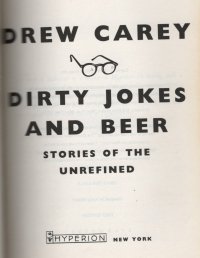 Wow, this book is almost thirty years old. I bought it at some point since then–the historical records (the blog here) are incomplete as to when, but the copy I have is a hardback without the dustjacket and has only the price marked in pencil on the frontspiece. The book, he acknowledges a with a smirk, is a bit of a money grab based on the popularity of his television show The Drew Carey Show during the Clinton administration.
Wow, this book is almost thirty years old. I bought it at some point since then–the historical records (the blog here) are incomplete as to when, but the copy I have is a hardback without the dustjacket and has only the price marked in pencil on the frontspiece. The book, he acknowledges a with a smirk, is a bit of a money grab based on the popularity of his television show The Drew Carey Show during the Clinton administration.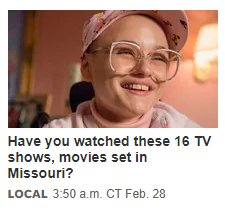
 I got this book
I got this book 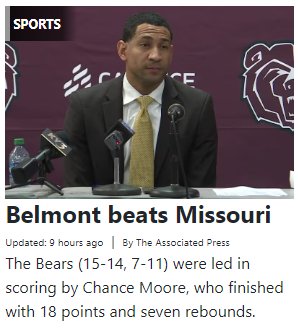
 After completing the 2024 Winter Reading Challenge, I took the opportunity to pop in some films. I was in the mood for this one for some reason, one that I thought maybe I could watch with my boys when they were old enough, but they’ve gotten too old now. Jeez, when did I pick this film up? Before I was enumerating film acquisitions on this blog, gentle reader, so a long time ago that was not so long ago.
After completing the 2024 Winter Reading Challenge, I took the opportunity to pop in some films. I was in the mood for this one for some reason, one that I thought maybe I could watch with my boys when they were old enough, but they’ve gotten too old now. Jeez, when did I pick this film up? Before I was enumerating film acquisitions on this blog, gentle reader, so a long time ago that was not so long ago. Well, since I just read the novelization of this film, of course I was going to rewatch the series. Well, the real Indiana Jones movies. I picked up a VHS box set from the turn of the century (it looks like the commentary is copyright 1999). Which is why the videocassettes call these Chapter 24, Chapter 23, and Chapter 25 respectively; the Young Indiana Jones Chronicles, a two season series plus four television movies, comprise the first 22 chapters of the story. And as far as the 21st century entries into the film canon go, well, we will not speak of them again.
Well, since I just read the novelization of this film, of course I was going to rewatch the series. Well, the real Indiana Jones movies. I picked up a VHS box set from the turn of the century (it looks like the commentary is copyright 1999). Which is why the videocassettes call these Chapter 24, Chapter 23, and Chapter 25 respectively; the Young Indiana Jones Chronicles, a two season series plus four television movies, comprise the first 22 chapters of the story. And as far as the 21st century entries into the film canon go, well, we will not speak of them again.
 This film, the events of which take place before Raiders of the Lost Ark, has a cold open where Jones has recovered the remains of a Chinese emperor for a gangster who does not want to pay and double-crosses Jones. Jones escapes with his life and the singer at the gangster’s nightclub, and although they (and Short Round, the annoying young sidekick) think they’ve gotten away, they’re passengers on a plane owned by the gangster–and the pilots bail out while Jones and crew are sleeping. Their narrow escape as the plane crashes in the Himalayas brings them to a village in India where the home stone has been stolen, and Jones decides to help return it. Which leads them to a fortress and a renegade rajah and a cult, including the cult leader who rips out still-beating hearts during rituals. Which is the gross-out moment in this film (akin to the face-melting in Raiders of the Lost Ark).
This film, the events of which take place before Raiders of the Lost Ark, has a cold open where Jones has recovered the remains of a Chinese emperor for a gangster who does not want to pay and double-crosses Jones. Jones escapes with his life and the singer at the gangster’s nightclub, and although they (and Short Round, the annoying young sidekick) think they’ve gotten away, they’re passengers on a plane owned by the gangster–and the pilots bail out while Jones and crew are sleeping. Their narrow escape as the plane crashes in the Himalayas brings them to a village in India where the home stone has been stolen, and Jones decides to help return it. Which leads them to a fortress and a renegade rajah and a cult, including the cult leader who rips out still-beating hearts during rituals. Which is the gross-out moment in this film (akin to the face-melting in Raiders of the Lost Ark). I saw this film in the theater, gentle reader, I think. It seems to me that my brother and I came into a windfall that summer when the owner of my father’s favorite tavern at the time hired us to load a roll-on dumpster with junk stored in the three- or four-bay garage attached to the saloon. We worked two days and got sixty dollars each, and, gentle reader, we could do anything we wanted. So we went to see this film instead of UHF because this film had been out for a while and would likely be ending its run, and UHF had just opened. Well, as it happens, UHF also closed before this film. But we saw it at the first run theater on Mill Road, not the second run theater which was across the street. We had a wealth of options in the world; I guess we have a wealth of options now in our homes, but it really isn’t the same.
I saw this film in the theater, gentle reader, I think. It seems to me that my brother and I came into a windfall that summer when the owner of my father’s favorite tavern at the time hired us to load a roll-on dumpster with junk stored in the three- or four-bay garage attached to the saloon. We worked two days and got sixty dollars each, and, gentle reader, we could do anything we wanted. So we went to see this film instead of UHF because this film had been out for a while and would likely be ending its run, and UHF had just opened. Well, as it happens, UHF also closed before this film. But we saw it at the first run theater on Mill Road, not the second run theater which was across the street. We had a wealth of options in the world; I guess we have a wealth of options now in our homes, but it really isn’t the same. Well, I could not have read this for the
Well, I could not have read this for the  I bought this book at Rublecon
I bought this book at Rublecon 
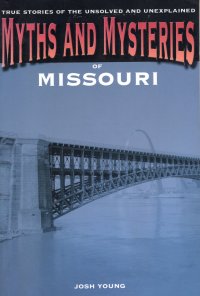 To be honest, I was a bit down on this book when I first started reading it. The first chapter is about Jim the Wonder Dog, and I just read a whole book about him
To be honest, I was a bit down on this book when I first started reading it. The first chapter is about Jim the Wonder Dog, and I just read a whole book about him